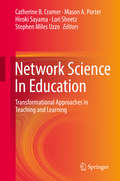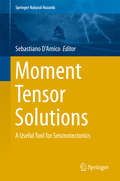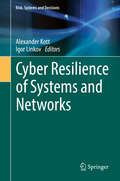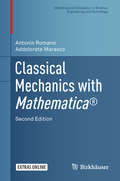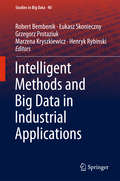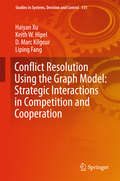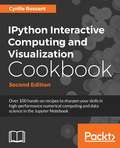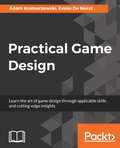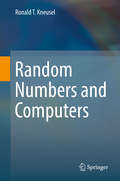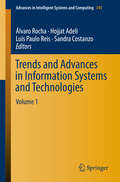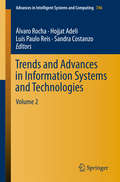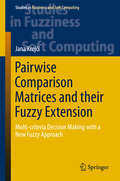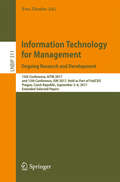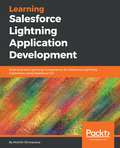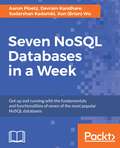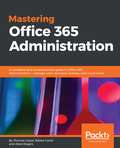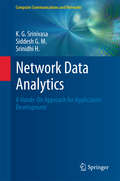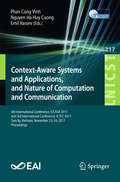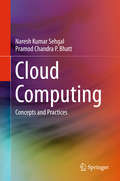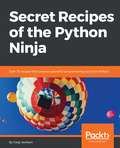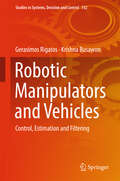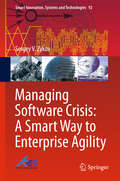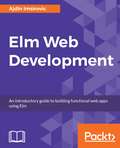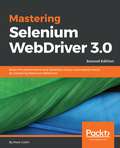- Table View
- List View
Network Science In Education: Transformational Approaches in Teaching and Learning
by Mason A. Porter Hiroki Sayama Catherine B. Cramer Lori Sheetz Stephen Miles UzzoAround the globe, there is an increasingly urgent need to provide opportunities for learners to embrace complexity; to develop the many skills and habits of mind that are relevant to today's complex and interconnected world; and to make learning more connected to our rapidly changing workplace and society. This presents an opportunity to (1) leverage new paradigms for understanding the structure and function of teaching and learning communities, and (2) to promote new approaches to developing methods, curricular materials, and resources. Network science - the study of connectivity - can play an important role in these activities, both as an important subject in teaching and learning and as a way to develop interconnected curricula. Since 2010, an international community of network science researchers and educators has come together to raise the global level of network literacy by applying ideas from network science to teaching and learning. Network Science in Education - which refers to both this community and to its activities - has evolved in response to the escalating activity in the field of network science and the need for people to be able to access the field through education channels. Network Science In Education: Transformational Approaches in Teaching and Learning appeals to both instructors and professionals, while offering case studies from a wide variety of activities that have been developed around the globe: the creation of entirely new courses and degree programs; tools for K-20 learners, teachers, and the general public; and in-depth analysis of selected programs. As network-based pedagogy and the community of practice continues to grow, we hope that the book's readers will join this vibrant network education community to build on these nascent ideas and help deepen the understanding of networks for all learners.
Moment Tensor Solutions: A Useful Tool For Seismotectonics (Springer Natural Hazards Ser.)
by Sebastiano D'AmicoThis book first focuses on the explanation of the theory about focal mechanisms and moment tensor solutions and their role in the modern seismology. The second part of the book compiles several state-of-the-art case studies in different seismotectonic settings of the planet.The assessment of seismic hazard and the reduction of losses due to future earthquakes is probably the most important contribution of seismology to society. In this regard, the understanding of reliable determination seismic source and of its uncertainty can play a key role in contributing to geodynamic investigation, seismic hazard assessment and earthquake studies. In the last two decades, the use of waveforms recorded at local-to-regional distances has increased considerably. Waveform modeling has been used also to estimate faulting parameters of small-to-moderate sized earthquakes.
Cyber Resilience of Systems and Networks (Risk, Systems and Decisions)
by Alexander Kott Igor LinkovThis book introduces fundamental concepts of cyber resilience, drawing expertise from academia, industry, and government. Resilience is defined as the ability to recover from or easily adjust to shocks and stresses. Unlike the concept of security - which is often and incorrectly conflated with resilience -- resilience refers to the system's ability to recover or regenerate its performance after an unexpected impact produces a degradation in its performance. A clear understanding of distinction between security, risk and resilience is important for developing appropriate management of cyber threats. The book presents insightful discussion of the most current technical issues in cyber resilience, along with relevant methods and procedures. Practical aspects of current cyber resilience practices and techniques are described as they are now, and as they are likely to remain in the near term.The bulk of the material is presented in the book in a way that is easily accessible to non-specialists. Logical, consistent, and continuous discourse covering all key topics relevant to the field will be of use as teaching material as well as source of emerging scholarship in the field. A typical chapter provides introductory, tutorial-like material, detailed examples, in-depth elaboration of a selected technical approach, and a concise summary of key ideas.
Classical Mechanics with Mathematica® (Modeling and Simulation in Science, Engineering and Technology #0)
by Antonio Romano Addolorata MarascoThis textbook takes a broad yet thorough approach to mechanics, aimed at bridging the gap between classical analytic and modern differential geometric approaches to the subject. Developed by the authors from over 30 years of teaching experience, the presentation is designed to give students an overview of the many different models used through the history of the field—from Newton to Hamilton—while also painting a clear picture of the most modern developments. The text is organized into two parts. The first focuses on developing the mathematical framework of linear algebra and differential geometry necessary for the remainder of the book. Topics covered include tensor algebra, Euclidean and symplectic vector spaces, differential manifolds, and absolute differential calculus. The second part of the book applies these topics to kinematics, rigid body dynamics, Lagrangian and Hamiltonian dynamics, Hamilton–Jacobi theory, completely integrable systems, statistical mechanics of equilibrium, and impulsive dynamics, among others. This new edition has been completely revised and updated and now includes almost 200 exercises, as well as new chapters on celestial mechanics, one-dimensional continuous systems, and variational calculus with applications. Several Mathematica® notebooks are available to download that will further aid students in their understanding of some of the more difficult material. Unique in its scope of coverage and method of approach, Classical Mechanics with Mathematica® will be useful resource for graduate students and advanced undergraduates in applied mathematics and physics who hope to gain a deeper understanding of mechanics.
Intelligent Methods and Big Data in Industrial Applications (Studies in Big Data #40)
by Marzena Kryszkiewicz Robert Bembenik Łukasz Skonieczny Henryk Rybinski Grzegorz ProtaziukThe inspiration for this book came from the Industrial Session of the ISMIS 2017 Conference in Warsaw. It covers numerous applications of intelligent technologies in various branches of the industry. Intelligent computational methods and big data foster innovation and enable the industry to overcome technological limitations and explore the new frontiers. Therefore it is necessary for scientists and practitioners to cooperate and inspire each other, and use the latest research findings to create new designs and products. As such, the contributions cover solutions to the problems experienced by practitioners in the areas of artificial intelligence, complex systems, data mining, medical applications and bioinformatics, as well as multimedia- and text processing. Further, the book shows new directions for cooperation between science and industry and facilitates efficient transfer of knowledge in the area of intelligent information systems.
Conflict Resolution Using the Graph Model: Strategic Interactions in Competition and Cooperation (Studies in Systems, Decision and Control #153)
by D. Marc Kilgour Keith W. Hipel Liping Fang Haiyan XuThis cutting-edge book presents the theory and practice of the Graph Model for Conflict Resolution (GMCR), which is used for strategically investigating disputes in any field to enable informed decision making. It clearly explains how GMCR can determine what is the best a particular decision maker (DM) can independently achieve in dynamic interaction with others. Moves and counter-moves follow various stability definitions reflecting human behavior under conflict. The book defines a wide range of preference structures to represent a DM’s comparisons of states or scenarios: equally preferred, more or less preferred; unknown; degrees of strength of preference; and hybrid. It vividly describes how GMCR can ascertain whether a DM can fare even better by cooperating with others in a coalition. The book portrays how a conflict can evolve from the status quo to a desirable resolution, and provides a universal design for a decision support system to implement the innovative decision technologies using the matrix formulation of GMCR. Further, it illustrates the key ideas using real-world conflicts and supplies problems at the end of each chapter. As such, this highly instructive book benefits teachers, mentors, students and practitioners in any area where conflict arises.
IPython Interactive Computing and Visualization Cookbook, Second Edition: Over 100 hands-on recipes to sharpen your skills in high-performance numerical computing and data science in the Jupyter Notebook
by Cyrille RossantLearn to use IPython and Jupyter Notebook for your data analysis and visualization work. Key Features Leverage the Jupyter Notebook for interactive data science and visualization Become an expert in high-performance computing and visualization for data analysis and scientific modeling A comprehensive coverage of scientific computing through many hands-on, example-driven recipes with detailed, step-by-step explanations Book Description Python is one of the leading open source platforms for data science and numerical computing. IPython and the associated Jupyter Notebook offer efficient interfaces to Python for data analysis and interactive visualization, and they constitute an ideal gateway to the platform. IPython Interactive Computing and Visualization Cookbook, Second Edition contains many ready-to-use, focused recipes for high-performance scientific computing and data analysis, from the latest IPython/Jupyter features to the most advanced tricks, to help you write better and faster code. You will apply these state-of-the-art methods to various real-world examples, illustrating topics in applied mathematics, scientific modeling, and machine learning. The first part of the book covers programming techniques: code quality and reproducibility, code optimization, high-performance computing through just-in-time compilation, parallel computing, and graphics card programming. The second part tackles data science, statistics, machine learning, signal and image processing, dynamical systems, and pure and applied mathematics. What you will learn Master all features of the Jupyter Notebook Code better: write high-quality, readable, and well-tested programs; profile and optimize your code; and conduct reproducible interactive computing experiments Visualize data and create interactive plots in the Jupyter Notebook Write blazingly fast Python programs with NumPy, ctypes, Numba, Cython, OpenMP, GPU programming (CUDA), parallel IPython, Dask, and more Analyze data with Bayesian or frequentist statistics (Pandas, PyMC, and R), and learn from actual data through machine learning (scikit-learn) Gain valuable insights into signals, images, and sounds with SciPy, scikit-image, and OpenCV Simulate deterministic and stochastic dynamical systems in Python Familiarize yourself with math in Python using SymPy and Sage: algebra, analysis, logic, graphs, geometry, and probability theory Who this book is for This book is intended for anyone interested in numerical computing and data science: students, researchers, teachers, engineers, analysts, and hobbyists. A basic knowledge of Python/NumPy is recommended. Some skills in mathematics will help you understand the theory behind the computational methods.
Practical Game Design: Learn the art of game design through applicable skills and cutting-edge insights
by Ennio De Nucci Adam KramarzewskiDesign accessible and creative games across genres, platforms, and development realitiesKey FeaturesImplement the skills and techniques required to work in a professional studioAce the core principles and processes of level design, world building, and storytellingDesign interactive characters that animate the gaming worldBook DescriptionIf you are looking for an up-to-date and highly applicable guide to game design, then you have come to the right place! Immerse yourself in the fundamentals of game design with this book, written by two highly experienced industry professionals to share their profound insights as well as give valuable advice on creating games across genres and development platforms.Practical Game Design covers the basics of game design one piece at a time. Starting with learning how to conceptualize a game idea and present it to the development team, you will gradually move on to devising a design plan for the whole project and adapting solutions from other games. You will also discover how to produce original game mechanics without relying on existing reference material, and test and eliminate anticipated design risks. You will then design elements that compose the playtime of a game, followed by making game mechanics, content, and interface accessible to all players. You will also find out how to simultaneously ensure that the gameplay mechanics and content are working as intended.As the book reaches its final chapters, you will learn to wrap up a game ahead of its release date, work through the different challenges of designing free-to-play games, and understand how to significantly improve their quality through iteration, polishing and playtesting.What you will learnDefine the scope and structure of a game projectConceptualize a game idea and present it to othersDesign gameplay systems and communicate them clearly and thoroughlyBuild and validate engaging game mechanicsDesign successful business models and prepare your games for live operationsMaster the principles behind level design, worldbuilding and storytellingImprove the quality of a game by playtesting and polishing itWho this book is forWhether you are a student eager to design a game or a junior game designer looking for your first role as a professional, this book will help you with the fundamentals of game design. By focusing on best practices and a pragmatic approach, Practical Game Design provides insights into the arts and crafts from two senior game designers that will interest more seasoned professionals in the game industry.
Random Numbers and Computers
by Ronald T. KneuselThis book covers pseudorandom number generation algorithms, evaluation techniques, and offers practical advice and code examples. Random Numbers and Computers is an essential introduction or refresher on pseudorandom numbers in computer science. The first comprehensive book on the topic, readers are provided with a practical introduction to the techniques of pseudorandom number generation, including how the algorithms work and how to test the output to decide if it is suitable for a particular purpose. Practical applications are demonstrated with hands-on presentation and descriptions that readers can apply directly to their own work. Examples are in C and Python and given with an emphasis on understanding the algorithms to the point of practical application. The examples are meant to be implemented, experimented with and improved/adapted by the reader.
Trends and Advances in Information Systems and Technologies: Volume 1 (Advances In Intelligent Systems And Computing #745)
by Hojjat Adeli Álvaro Rocha Luís Paulo Reis Sandra CostanzoThis book includes a selection of papers from the 2018 World Conference on Information Systems and Technologies (WorldCIST'18), held in Naples, Italy on March27-29, 2018. WorldCIST is a global forum for researchers and practitioners to present and discuss recent results and innovations, current trends, professional experiences and the challenges of modern information systems and technologies research together with their technological development and applications.The main topics covered are: A) Information and Knowledge Management; B) Organizational Models and Information Systems; C) Software and Systems Modeling; D) Software Systems, Architectures, Applications and Tools; E) Multimedia Systems and Applications; F) Computer Networks, Mobility and Pervasive Systems; G) Intelligent and Decision Support Systems; H) Big Data Analytics and Applications; I) Human–Computer Interaction; J) Ethics, Computers & Security; K) Health Informatics; L) Information Technologies in Education; M) Information Technologies in Radiocommunications; N) Technologies for Biomedical Applications.
Trends and Advances in Information Systems and Technologies: Volume 1 (Advances In Intelligent Systems And Computing #745)
by Hojjat Adeli Álvaro Rocha Luís Paulo Reis Sandra CostanzoThis book includes a selection of papers from the 2018 World Conference on Information Systems and Technologies (WorldCIST'18), held in Naples, Italy on March27-29, 2018. WorldCIST is a global forum for researchers and practitioners to present and discuss recent results and innovations, current trends, professional experiences and the challenges of modern information systems and technologies research together with their technological development and applications. The main topics covered are: A) Information and Knowledge Management; B) Organizational Models and Information Systems; C) Software and Systems Modeling; D) Software Systems, Architectures, Applications and Tools; E) Multimedia Systems and Applications; F) Computer Networks, Mobility and Pervasive Systems; G) Intelligent and Decision Support Systems; H) Big Data Analytics and Applications; I) Human–Computer Interaction; J) Ethics, Computers & Security; K) Health Informatics; L) Information Technologies in Education; M) Information Technologies in Radiocommunications; N) Technologies for Biomedical Applications.
Pairwise Comparison Matrices and their Fuzzy Extension: Multi-criteria Decision Making With A New Fuzzy Approach (Studies in Fuzziness and Soft Computing #366)
by Jana KrejčíThis book offers the first comprehensive and critical literature review of fuzzy pairwise comparison methods derived from methods originally developed for crisp pairwise comparison matrices. It proposes new fuzzy extensions of these methods and provides a detailed study of the differences and analogies between all the reviewed methods, as well as a detailed description of their drawbacks, with the help of many numerical examples. In order to prevent the drawbacks related to the reviewed fuzzy pairwise comparison methods, the book introduces constrained fuzzy arithmetic in fuzzy extension of the pairwise comparison methods. It proposes new fuzzy pairwise comparison methods based on constrained fuzzy arithmetic and critically compares them with the reviewed methods. It describes the application of the newly developed methods to incomplete large-dimensional pairwise comparison matrices showcased in a real-life case study. Written for researchers, graduate and PhD students interested in multi-criteria decision making methods based on both crisp and fuzzy pairwise comparison matrices, this self-contained book offers an overview of cutting-edge research and all necessary information to understand the described tools and use them in real-world applications.
Information Technology for Management. Ongoing Research and Development: 15th Conference, Aitm 2017, And 12th Conference, Ism 2017, Held As Part Of Fedcsis, Prague, Czech Republic, September 3-6, 2017, Extended Selected Papers (Lecture Notes In Business Information Processing #311)
by Ewa ZiembaThis book constitutes extended selected papers from the 15th Conference on Advanced Information Technologies for Management, AITM 2017, and the 12th Conference on Information Systems Management, ISM 2017, held as part of the Federated Conference on Computer Science and Information Systems, FedCSIS, which took place in Prague, Poland, in September 2017. The 13 papers presented in this volume were carefully reviewed and selected from 48 submissions. They were organized in topical sections named: information technology and systems for knowledge management; information technology and systems for business transformation; and implementation and evaluation of information systems.
Learning Salesforce Lightning Application Development: Build and test Lightning Components for Salesforce Lightning Experience using Salesforce DX
by Mohith ShrivastavaBuild, design, and style beautiful and informative applications on the Salesforce Lightning platformKey FeaturesBuild and Test Lightning Components that enhance application usability and adaptabilityApply Security Best Practices to your Custom Lightning ComponentsDesign Lightning Components for Salesforce UIs such as Lightning Pages, Salesforce 1 Application, Communities, and more.Book DescriptionBuilt on the Salesforce App Cloud, the new Salesforce Lightning Experience combines three major components: Lightning Design System, Lightning App Builder, and Lightning Components, to provide an enhanced user experience. This book will enable you to quickly create modern, enterprise apps with Lightning Component Framework.You will start by building simple Lightning Components and understanding the Lightning Components architecture. The chapters cover the basics of Lightning Component Framework semantics and syntax, the security features provided by Locker Service, and use of third-party libraries inside Lightning Components. The later chapters focus on debugging, performance tuning, testing using Lightning Testing Services, and how to publish Lightning Components on Salesforce AppExchange.What you will learnUnderstand Lightning Components architecture Learn Locker security best practices Debug and Improve performance of your Lightning Components Use third-party libraries along with Lightning Component FrameworkLearn how to publish Lightning Components on AppExchangeUse Lightning Out to take your Lightning Components outside the Salesforce platformWho this book is forThis book is for Salesforce developers or developers from other platforms who are familiar with HTML, CSS, and JavaScript and want to build and test Salesforce Lightning components. No knowledge of Salesforce Lightning is required.
Machine Learning with Swift: Artificial Intelligence for iOS
by Oleksandr Sosnovshchenko Oleksandr BaievLeverage the power of machine learning and Swift programming to build intelligent iOS applications with ease Key Features Implement effective machine learning solutions for your iOS applications Use Swift and Core ML to build and deploy popular machine learning models Develop neural networks for natural language processing and computer vision Book Description Machine learning as a field promises to bring increased intelligence to the software by helping us learn and analyse information efficiently and discover certain patterns that humans cannot. This book will be your guide as you embark on an exciting journey in machine learning using the popular Swift language. We’ll start with machine learning basics in the first part of the book to develop a lasting intuition about fundamental machine learning concepts. We explore various supervised and unsupervised statistical learning techniques and how to implement them in Swift, while the third section walks you through deep learning techniques with the help of typical real-world cases. In the last section, we will dive into some hard core topics such as model compression, GPU acceleration and provide some recommendations to avoid common mistakes during machine learning application development. By the end of the book, you'll be able to develop intelligent applications written in Swift that can learn for themselves. What you will learn Learn rapid model prototyping with Python and Swift Deploy pre-trained models to iOS using Core ML Find hidden patterns in the data using unsupervised learning Get a deeper understanding of the clustering techniques Learn modern compact architectures of neural networks for iOS devices Train neural networks for image processing and natural language processingWho this book is for iOS developers who wish to create smarter iOS applications using the power of machine learning will find this book to be useful. This book will also benefit data science professionals who are interested in performing machine learning on mobile devices. Familiarity with Swift programming is all you need to get started with this book.
Seven NoSQL Databases in a Week: Get up and running with the fundamentals and functionalities of seven of the most popular NoSQL databases
by Xun Brian Wu Sudarshan Kadambi Devram Kandhare Aaron PloetzA beginner's guide to get you up and running with Cassandra, DynamoDB, HBase, InfluxDB, MongoDB, Neo4j, and RedisKey FeaturesCovers the basics of 7 NoSQL databases and how they are used in the enterprisesQuick introduction to MongoDB, DynamoDB, Redis, Cassandra, Neo4j, InfluxDB, and HBaseIncludes effective techniques for database querying and managementBook DescriptionThis is the golden age of open source NoSQL databases. With enterprises having to work with large amounts of unstructured data and moving away from expensive monolithic architecture, the adoption of NoSQL databases is rapidly increasing. Being familiar with the popular NoSQL databases and knowing how to use them is a must for budding DBAs and developers.This book introduces you to the different types of NoSQL databases and gets you started with seven of the most popular NoSQL databases used by enterprises today. We start off with a brief overview of what NoSQL databases are, followed by an explanation of why and when to use them. The book then covers the seven most popular databases in each of these categories: MongoDB, Amazon DynamoDB, Redis, HBase, Cassandra, InfluxDB, and Neo4j. The book doesn't go into too much detail about each database but teachesyou enough to get started with them.By the end of this book, you will have a thorough understanding of the different NoSQL databases and their functionalities, empowering you to select and use the rightdatabase according to your needs.What you will learnUnderstand how MongoDB provides high-performance, high-availability, and automatic scalingInteract with your Neo4j instances via database queries, Python scripts, and Java application codeGet familiar with common querying and programming methods to interact with RedisStudy the different types of problems Cassandra can solveWork with HBase components to support common operations such as creating tables and reading/writing dataDiscover data models and work with CRUD operations using DynamoDBDiscover what makes InfluxDB a great choice for working withtime-series dataWho this book is forIf you are a budding DBA or a developer who wants to get started with the fundamentals of NoSQL databases, this book is for you. Relational DBAs who want to get insights into the various offerings of popular NoSQL databases will also find this book to be very useful.
Mastering Office 365 Administration: A complete and comprehensive guide to Office 365 Administration - manage users, domains, licenses, and much more
by Thomas Carpe Alara Rogers Nikkia CarterLeverage Office 365 to increase your organization's efficiencyKey FeaturesPerform common to advanced-level management and administrative tasks for your organization with Office 365 Become an Office 365 generalist who can work with the entire stack—not just specific productsAn advanced-level guide that will teach you to implement enterprise-level services into your organization, no matter the size of the businessBook DescriptionIn today's world, every organization aims to migrate to the cloud in order to become more efficient by making full use of the latest technologies. Office 365 is your one-stop solution to making your organization reliable, scalable, and fast.This book will start with an overview of Office 365 components, and help you learn how to use the administration portal, and perform basic administration. It then goes on to cover common management tasks, such as managing users, admin roles, groups, securing Office 365, and enforcing compliance. In the next set of chapters, you will learn about topics including managing Skype for Business Online, Yammer, OneDrive for Business, and Microsoft Teams. In the final section of the book, you will learn how to carry out reporting and monitor Office 365 service health.By the end of this book, you will be able to implement enterprise-level services with Office 365 based on your organization's needs.What you will learn Understand the vast Office 365 feature set Understand how workloads and applications interact and integrate with each other Connect PowerShell to various Office 365 services and perform tasks Manage Skype for Business Online Get support and monitor Office 365 service health Manage and administer identities and groups efficientlyWho this book is forThis book targets architects, sys admins, engineers, and administrators who are working with Office 365 and are responsible for configuring, implementing, and managing Office 365 in their organization. A prior knowledge of Office 365 and Exchange servers is mandatory.
Network Data Analytics: A Hands-on Approach For Application Development (Computer Communications and Networks)
by K. G. Srinivasa Siddesh G. M. Srinidhi H.In order to carry out data analytics, we need powerful and flexible computing software. However the software available for data analytics is often proprietary and can be expensive. This book reviews Apache tools, which are open source and easy to use. After providing an overview of the background of data analytics, covering the different types of analysis and the basics of using Hadoop as a tool, it focuses on different Hadoop ecosystem tools, like Apache Flume, Apache Spark, Apache Storm, Apache Hive, R, and Python, which can be used for different types of analysis. It then examines the different machine learning techniques that are useful for data analytics, and how to visualize data with different graphs and charts. Presenting data analytics from a practice-oriented viewpoint, the book discusses useful tools and approaches for data analytics, supported by concrete code examples. The book is a valuable reference resource for graduate students and professionals in related fields, and is also of interest to general readers with an understanding of data analytics.
Context-Aware Systems and Applications, and Nature of Computation and Communication: 6th International Conference, Iccasa 2017, And 3rd International Conference, Ictcc 2017, Tam Ky, Vietnam, November 23-24, 2017, Proceedings (Lecture Notes of the Institute for Computer Sciences, Social Informatics and Telecommunications Engineering #217)
by Emil Vassev Phan Cong Vinh Nguyen Ha Huy CuongThis book constitutes the refereed post-conference proceedings of the International Conferences ICCASA and ICTCC 2017, held in November 2017 in Tam Ky City, Vietnam. The 23 revised full papers presented were carefully selected from 31 submissions. The papers of ICCASA cover a wide spectrum in the area of context-aware-systems. CAS is characterized by its self- facets such as self-organization, self-configuration, self-healing, self-optimization, self-protection used to dynamically control computing and networking functions. The papers of ICTCC cover formal methods for self-adaptive systems and discuss natural approaches and techniques for computation and communication.
Cloud Computing: Concepts And Practices
by Naresh Kumar Sehgal Pramod Chandra P. BhattThis book provides readers with an overview of Cloud Computing, starting with historical background on mainframe computers and early networking protocols, leading to current concerns such as hardware and systems security, performance, emerging areas of IoT, Edge Computing etc. Readers will benefit from the in-depth discussion of cloud computing usage and the underlying architecture, with focus on best practices for using a dynamic cloud infrastructure, cloud operations management and cloud security. The authors explain carefully the “why’s and how’s” of Cloud Computing, so engineers will find this book and invaluable introduction to the topic.
Secret Recipes of the Python Ninja: Over 70 recipes that uncover powerful programming tactics in Python
by Cody JacksonTest your Python programming skills by solving real-world problemsKey FeaturesAccess built-in documentation tools and improve your code.Discover how to make the best use of decorator and generator functionsEnhance speed and improve concurrency by conjuring tricks from the PyPy projectBook DescriptionThis book covers the unexplored secrets of Python, delve into its depths, and uncover its mysteries.You’ll unearth secrets related to the implementation of the standard library, by looking at how modules actually work. You’ll understand the implementation of collections, decimals, and fraction modules. If you haven’t used decorators, coroutines, and generator functions much before, as you make your way through the recipes, you’ll learn what you’ve been missing out on. We’ll cover internal special methods in detail, so you understand what they are and how they can be used to improve the engineering decisions you make. Next, you’ll explore the CPython interpreter, which is a treasure trove of secret hacks that not many programmers are aware of. We’ll take you through the depths of the PyPy project, where you’ll come across several exciting ways that you can improve speed and concurrency. Finally, we’ll take time to explore the PEPs of the latest versions to discover some interesting hacks.What you will learnKnow the differences between .py and .pyc files Explore the different ways to install and upgrade Python packagesUnderstand the working of the PyPI module that enhances built-in decoratorsSee how coroutines are different from generators and how they can simulate multithreadingGrasp how the decimal module improves floating point numbers and their operationsStandardize sub interpreters to improve concurrencyDiscover Python’s built-in docstring analyzerWho this book is forWhether you’ve been working with Python for a few years or you’re a seasoned programmer, you’ll have a lot of new tricks to walk away with.
Robotic Manipulators and Vehicles: Control, Estimation And Filtering (Studies in Systems, Decision and Control #152)
by Krishna Busawon Gerasimos RigatosThis monograph addresses problems of:• nonlinear control, estimation and filtering for robotic manipulators (multi-degree-of freedom rigid-link robots, flexible-link robots, underactuated, redundant and cooperating manipulators and closed-chain robotic mechanisms); and• nonlinear control, estimation and filtering for autonomous robotic vehicles operating on the ground, in the air, and on and under water, independently and in cooperating groups.The book is a thorough treatment of the entire range of applications of robotic manipulators and autonomous vehicles. The nonlinear control and estimation methods it develops can be used generically, being suitable for a wide range of robotic systems. Such methods can improve robustness, precision and fault-tolerance in robotic manipulators and vehicles at the same time as enabling the reliable functioning of these systems under variable conditions, model uncertainty and external perturbations.
Managing Software Crisis: A Smart Way to Enterprise Agility (Smart Innovation, Systems And Technologies #92)
by Sergey V. ZykovThis book discusses smart, agile software development methods and their applications for enterprise crisis management, presenting a systematic approach that promotes agility and crisis management in software engineering. The key finding is that these crises are caused by both technology-based and human-related factors. Being mission-critical, human-related issues are often neglected. To manage the crises, the book suggests an efficient agile methodology including a set of models, methods, patterns, practices and tools. Together, these make a survival toolkit for large-scale software development in crises. Further, the book analyses lifecycles and methodologies focusing on their impact on the project timeline and budget, and incorporates a set of industry-based patterns, practices and case studies, combining academic concepts and practices of software engineering.
Elm Web Development: An introductory guide to building functional web apps using Elm
by Ajdin ImsirovicExplore why ELM is a great alternative to using pure JavaScript and other JS-based solutions by building complete apps and websites.Key FeaturesDevelop your own scalable and modular web applications with Elm to make web development less messy compared to your JavaScript appsCreate personal portfolio website, a weather application, and a unit conversion website, and integrate your Elm apps with Rails 5Boost the performance of your application with no runtime exceptions and JavaScript interoperabilityBook DescriptionWeb development with JavaScript usually involves dealing with performance and maintenance issues. JavaScript fatigue makes it difficult for many developers to keep up with the increasing complexity posed by the multitude of JavaScript frameworks with changing versions, and the need to use different tools such as task runners, module bundlers, compilers, testing suites, linting and debuggers. Elm is an easy-to-learn, functional programming language that simplifies web development by eliminating the complexity associated with using JavaScript for web development. Elm is a statically typed language and thus makes a front end web developer's life easier by preventing run-time errors.You will begin by seeing the bigger picture of where Elm fits into the web development world and learning the basics of Elm programming. Firstly, you will get a taste for web development with Elm by developing a simple fizz-buzz app. Next you will get hands-on with advanced Elm concepts as you develop your own personal blogging website, a unit conversion app and a weather app with Elm. Finally, you will also learn how to integrate Elm with a Rails 5 app with the help of Webpack. By the end of the book you will have learned Elm programming, and its applications, and will appreciate how Elm simplifies web development for you.What you will learnProgramming with the Elm language, its syntax and core concepts Using Elm for front end web development projectsDeveloping complete websites with ElmDecoding JSON into ElmIntegrating Elm with the standard front end web development technologiesIntegrating Elm with back-end frameworksTesting your applications in ElmWho this book is forThis book is for frontend web developers who want to learn a simpler way of developing their applications. A knowledge of the basics of CSS and Bootstrap is required.
Mastering Selenium WebDriver 3.0: Boost the performance and reliability of your automated checks by mastering Selenium WebDriver, 2nd Edition
by Mark Patrick Leigh CollinComplement Selenium with useful additions that fit seamlessly into the rich and well-crafted API that Selenium offersKey FeaturesUnderstand the power, simplicity, and limitations of the core Selenium frameworkWrite clear, readable, and reliable tests that perform complex test automation tasksWork with ChromeDriver and GeckoDriver in headless modeBook DescriptionThe second edition of Mastering Selenium 3.0 WebDriver starts by showing you how to build your own Selenium framework with Maven. You'll then look at how you can solve the difficult problems that you will undoubtedly come across as you start using Selenium in an enterprise environment and learn how to produce the right feedback when failing. Next, you’ll explore common exceptions that you will come across as you use Selenium, the root causes of these exceptions, and how to fix them. Along the way, you’ll use Advanced User Interactions APIs, running any JavaScript you need through Selenium; and learn how to quickly spin up a Selenium Grid using Docker containers. In the concluding chapters, you‘ll work through a series of scenarios that demonstrate how to extend Selenium to work with external libraries and applications so that you can be sure you are using the right tool for the job.What you will learnProvide fast, useful feedback with screenshotsCreate extensible, well-composed page objectsUtilize ChromeDriver and GeckoDriver in headless modeLeverage the full power of Advanced User Interactions APIsUse JavascriptExecutor to execute JavaScript snippets in the browser through SeleniumBuild user interaction into your test script using JavascriptExecutorLearn the basics of working with AppiumWho this book is forIf you are a software tester or a developer with working experience in Selenium and competency with Java, who is interested in automation and are looking forward to taking the next step in their learning journey, then this is the book for you.
